Related Research Articles

Super Mario Kart is a kart racing game developed and published by Nintendo for the Super Nintendo Entertainment System (SNES). The first game in the Mario Kart series, it was released in Japan and North America in 1992, and in Europe the following year in 1993. Selling 8.76 million copies worldwide, the game went on to become the fourth best-selling SNES game of all time. Super Mario Kart was re-released on the Wii's Virtual Console in 2009, on the Wii U's Virtual Console in 2013, and on the New Nintendo 3DS's Virtual Console in 2016. Nintendo re-released Super Mario Kart in 2017 as part of the company's Super NES Classic Edition.

A platformer is a sub-genre of action video games in which the core objective is to move the player character between points in an environment. Platform games are characterized by levels with uneven terrain and suspended platforms of varying height that require jumping and climbing to traverse. Other acrobatic maneuvers may factor into the gameplay, such as swinging from vines or grappling hooks, jumping off walls, gliding through the air, or bouncing from springboards or trampolines.

Super Mario World 2: Yoshi's Island is a 1995 platform game developed and published by Nintendo for the Super Nintendo Entertainment System (SNES). The player controls Yoshi, a friendly dinosaur, on a quest to reunite baby Mario with his brother Luigi, who has been kidnapped by Kamek. Yoshi runs and jumps to reach the end of the level while solving puzzles and collecting items with Mario's help.
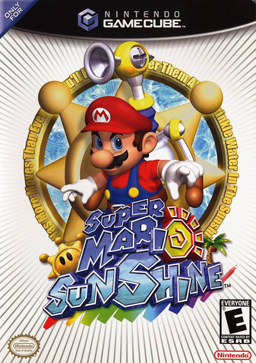
Super Mario Sunshine is a 2002 platform game developed and published by Nintendo for the GameCube. It is the second 3D game in the Super Mario series, following Super Mario 64 (1996). The game was directed by Yoshiaki Koizumi and Kenta Usui, produced by series creators Shigeru Miyamoto and Takashi Tezuka, written by Makoto Wada, and scored by Koji Kondo and Shinobu Tanaka.
Metroid is an action-adventure game franchise created by Nintendo. The player controls the bounty hunter Samus Aran, who protects the galaxy from Space Pirates and other malevolent forces and their attempts to harness the power of the parasitic Metroid creatures.
An action game is a video game genre that emphasizes physical challenges, including hand–eye coordination and reaction time. The genre includes a large variety of sub-genres, such as fighting games, beat 'em ups, shooter games, rhythm games and platform games. Multiplayer online battle arena and some real-time strategy games are also considered action games.

Mischief Makers is a side-scrolling platform game developed for the Nintendo 64 gaming console by Treasure, and published in 1997 by Enix in Japan and by Nintendo internationally. The player assumes the role of Marina Liteyears, a robotic maid who journeys to rescue her creator, Professor Theo, from the emperor of Planet Clancer. The gameplay is displayed in 2.5D, based on grabbing, shaking, and throwing objects within five worlds and 52 levels.
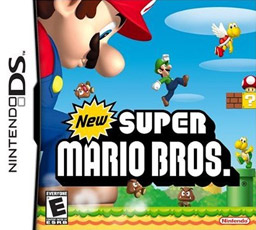
New Super Mario Bros. is a 2006 platform game developed and published by Nintendo for the Nintendo DS. It was first released in May 2006 in North America and Japan, and in PAL regions in June 2006. It is the first installment in the New Super Mario Bros. subseries of the Super Mario series and follows Mario as he fights his way through Bowser's henchmen to rescue Princess Peach. Mario has access to several old and new power-ups that help him complete his quest, including the Super Mushroom, the Fire Flower, and the Super Star, each giving him unique abilities. While traveling through eight worlds with more than 80 levels, Mario has to defeat Bowser Jr. and Bowser before saving Princess Peach.
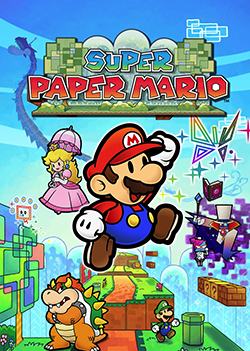
Super Paper Mario is a 2007 action role-playing game developed by Intelligent Systems and published by Nintendo for the Wii. It is the third installment in the Paper Mario series following Paper Mario: The Thousand-Year Door (2004), and the first Mario game on the Wii. The game follows Mario, Peach, Bowser, and Luigi as they attempt to collect Pure Hearts and stop Count Bleck and his minions from destroying the universe.

I Wanna Be the Guy: The Movie: The Game, commonly called I Wanna Be the Guy and abbreviated to IWBTG, is a freeware platform game created by Michael "Kayin" O'Reilly for Microsoft Windows using Multimedia Fusion 2. First released on October 5, 2007, the game is no longer in active development, though the game's source code was released by Kayin in 2011 and a remastered edition was released in 2020. IWBTG has unusually difficult platforming elements, unorthodox level design, and uses sound effects, characters, and music from many other games.

Super Meat Boy is a 2010 platform game designed by Edmund McMillen and Tommy Refenes under the collective name of "Team Meat". It was self-published as the successor to Meat Boy, a 2008 Flash game designed by McMillen and Jonathan McEntee. In the game, the player controls Meat Boy, a red, cube-shaped character, as he attempts to rescue his girlfriend, Bandage Girl, from the game's antagonist Dr. Fetus. The gameplay is characterized by fine control and split-second timing, as the player runs and jumps through over 300 hazardous levels while avoiding obstacles. The game also supports the creation of player-created levels. Super Meat Boy was first released on the Xbox 360 through Xbox Live Arcade in October 2010, and was later ported to Microsoft Windows, OS X, Linux, PlayStation 4, PlayStation Vita, Wii U, and the Nintendo Switch. A Wii version was in development but was ultimately cancelled.

Mario is a Japanese multimedia franchise created by Japanese game designer Shigeru Miyamoto for video game company Nintendo, which produces and publishes its installments. Starring the titular Italian plumber Mario, it is primarily a video game franchise but has extended to other forms of media, including television series, comic books, a 1993 feature film, a 2023 animated film, and theme park attractions. The series' first installment was 1983's Mario Bros. even though Mario made his first appearance in 1981's arcade game Donkey Kong and had already been featured in several games of the Donkey Kong and Game & Watch series. The Mario games have been developed by a wide variety of developers. Mario games have been released almost exclusively for Nintendo's various video game consoles and handhelds, from the third generation onward.

Mighty Jill Off is a 2008 independently developed freeware platform video game designed by Anna Anthropy, with art by James Harvey and music by Andrew Toups. It stars a submissive named Jill, who has a boot fetish and is forced to climb up a tower after her Queen kicks her down it as punishment. Jill does this by jumping and slowly descending over obstacles. Jill can be defeated in one hit by these obstacles, but will return to the last check point. The game serves as an homage to the 1984 arcade game Bomb Jack and its console and computer sequel, Mighty Bomb Jack. It had follow-ups, such as Mighty Jill Off - Jill Off Harder Edition and Jill Off With One Hand. Jill made a cameo appearance in the 2010 video game Super Meat Boy as a playable character.
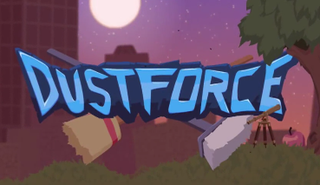
Dustforce is a platform video game developed by Hitbox Team. The game was released in 2012 for Microsoft Windows via Steam in January, and Mac OS X through Steam in May. A Linux port was released as part of the Humble Indie Bundle 6. Capcom published the game for the PlayStation 3, PlayStation Vita, and Xbox 360.

Celeste is a 2018 platform game developed and published by indie studio Maddy Makes Games. The player controls Madeline, a young woman with anxiety and depression who aims to climb Celeste Mountain. During her climb, she encounters several characters, including Part of You, a personification of her self-doubt who attempts to stop her from climbing the mountain.
"Nintendo hard" is an informal term used to describe extreme difficulty in video games. It often refers to games with trial-and-error gameplay and limited or nonexistent saving of progress. The enduring term originated with Nintendo Entertainment System (NES) games from the mid-1980s to early 1990s, such as Ghosts 'n Goblins (1986), Contra (1988), Ninja Gaiden (1988), and Battletoads (1991).

The King's Bird is a platform game developed by American indie game studio Serenity Forge and published by Canadian indie game publisher Graffiti Games. The game was released for Microsoft Windows on August 23, 2018 and presented at PAX East 2018 and the E3 Media Indie Exchange.
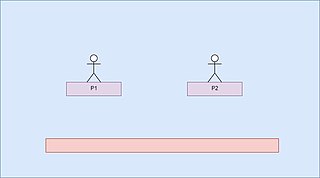
A platform fighter is a sub-genre of fighting games that emphasizes free 2D movement, often with floating platforms that can be traversed on, similar to a platformer game. The central gameplay involves combat between two or more player-controlled characters, with the goal of attacking an opponent's character until they are defeated.
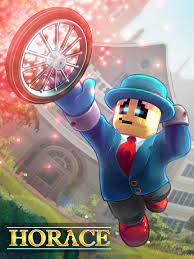
Horace is a 2019 video game developed by British indie developers Paul Helman and Sean Scaplehorn, and published by 505 Games. The game was originally launched for Microsoft Windows on July 19, 2019, with a Nintendo Switch port released on October 21, 2020. The game also released for PlayStation 4 and Xbox One on February 28, 2023. Players control the titular Horace, a sentient robot who is adopted by a wealthy British family. Following a period of dormancy, Horace is reactivated and finds himself searching for a sense of purpose in a war-torn post-apocalyptic world.
Dere Evil Exe is an indie platformer and horror video game developed by Darius Immanuel Guerrero and published by AppSir Games. It was released on May 29, 2018, on iOS, where it is adware with the option for an ad-free purchase, July 2, 2018, for Android and on July 3, 2018, for Windows as a paid game. A standalone sequel to previous indie games Sorority Rites and The Last Yandere, and a remake of the freeware game DERE EXE, the game is based on creepypasta stories about retro games, and has a self-aware story that breaks the fourth wall. Nominally a masocore fantasy platformer in which the player controls a knight character, Knightly, on a quest to save a princess, the game's rules are skewed, and the player is soon warned not to trust the game's developer messages or its assistant AI, AIDE. The game received mixed reviews from critics, who praised the story, but were split on whether the gameplay was of high quality.
References
- 1 2 Auerbach, David (18 March 2014). "Game Over and Over and Over". Slate. Archived from the original on 14 April 2019. Retrieved 3 August 2022.
- 1 2 3 4 Alexander, Julia (2014-09-05). "Unbeatable 2D Platformers Are All the Rage Among Hardcore Gamers". Vice. Retrieved 2022-04-11.
- ↑ Muncy, Julie (2019-07-10). "The 'Super Mario Maker 2' Community Is a Haven of Player Creativity". Wired. ISSN 1059-1028 . Retrieved 2022-04-11.
- ↑ Anthropy, Anna (6 April 2008). "masocore games". Auntie Pixelante. Archived from the original on 13 April 2008. Retrieved 3 August 2022.
- ↑ Treese, Tyler (2019-04-04). "Most Difficult 2D Platformers Ever | From Super Meat Boy to Dustforce". GameRevolution. Retrieved 2022-04-11.
- ↑ Saed, Sherif (2017-01-16). ""During development, we consciously avoided making the game easy" - Nioh director". VG247. Retrieved 2022-04-11.
- ↑ Frushtick, Russ (2018-05-24). "The Switch is the perfect console for masochists". Polygon. Retrieved 2022-04-11.